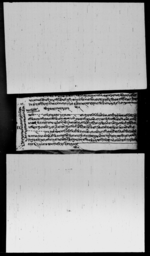A copy of a lālamohara to Raṅganātha Pauḍyāla renewing a grant of land [VS 1863]
ID: K_0096_0011
Edited and
translated by Simon Cubelic
in collaboration with
Rajan Khatiwoda
Created: 2017-04-16;
Last modified: 2018-06-21
For the metadata of the document, click here
The accompanying edition, translation/synopsis and/or commentary are available under the terms of the Creative Commons Attribution-ShareAlike 4.0 International License
Abstract
In this copy of a lālamohara, Raṅganātha Pauḍyāla is reinstated in the possession of an upland rice field around Nārāyaṇahiṭi as a tax-free birtābitalapa, which had earlier been granted to but later expropriated from his father Vrajanātha Pauḍyāla.Diplomatic edition
[1r]
श्रीः\1श्रीवुवाज्यूरणवहादुरसाह2२श्रीगुरुवाज्याव्रजनाथपंडितज्यू१श्रीगुरुपंडितराजरंगनाथपंडितज्यू३1प्रसस्तिसौ
2आगे¯ ¯१¯ ¯लाईसम्वत्१८३९सालमा¯ ¯२¯ ¯वाटकुसपानिलिडल्लोसंकल्पगरीसर्वअंकमारिमेटिवि
3र्तावितलपगरिवक्स्याकोविचमाअन्यायलेलडवडपरिछुट्याकोनारायणहिटिमाथिकोवगैचाकोजगाघै
4यावारिषेततस्कोसाध•पूर्ववाझोचौरनेवारकोसुनाविर्तागुठीरैकर•दछिननेवारकोसुनाविर्तागुठिरैकर
5पश्चिममुलवाटोउत्तरनेवारकोसुनाविर्तागुठिरैकरयेतिचारकिलाभित्रकाघैयाषेतकोवगैचा
6 ¯ ¯ ¯३¯ ¯ ¯ लाइसर्वअंकमारीमेटीविर्तावितलपकोलालमोहरगरिवक्स्यौंषातिर्ज्मासितसर्वअं
7कमाफ्भयाकोविर्तावितलपजानिसंतानदरसंतानसम्मसुषभोग्यगर्नुहवस्आसिरवादवक्सदै
8रहनुहव़स्स्वदत्तांपरदत्ताम्वायोहरेद्वैवसुन्धराम्षष्ठिवर्षसहश्राणिविष्टायांजायतेकृमीःइतिसम्व
9त्१८६३सालप्र•श्रावणवदि३०रोज३शुभम्¯¯¯¯¯¯¯¯¯¯¯¯¯¯¯¯¯¯¯¯¯¯¯¯¯¯¯¯¯¯¯
Translation
[1r]
Śrī
Venerable Father Raṇabahādura Śāha1 2
Venerable Gurubājyā2 Vrajanātha Paṇḍitajyū3 1
Venerable Guru Paṇḍitarāja Raṅganātha Paṇḍitajyū4 3
Āge: The upland rice (ghaiyā) field [on] the garden plot above Nārāyaṇahiṭi which was granted by -2- (i.e., Venerable Father Raṇabahādura Śāha) to -1- (i.e., Venerable Gurubājyā Vrajanātha Paṇḍitajyū) in the [Vikrama] era year 1839 as birtābitalapa—exempted from all taxes—after kuśa and water were brought and a saṃkalpa was performed on a clod (ḍallo)5 [from the plot]; but which in the interim he was unlawfully dispossessed of when he was [politically] weakened, has the [following] border demarcations: east [to] fallow ground [and] a Newar’s sunābirtā [and] the guṭhīraikara land; south [to] a Newar’s sunābirtā [and] the guṭhīraikara land; west to the main path; and north to a Newar’s sunābirtā [and] the guṭhīraikara land. We issue [this] lālamohara to -3- (i.e., Venerable Guru Paṇḍitarāja Raṅganātha Paṇḍitajyū) for [the portion of] the garden plot [consisting] of the upland rice field within these four boundaries as birtābitalapa exempted from all taxes. Enjoy happiness from generation to generation, thinking of it with content as birtābitalapa. Keep on blessing us.
Whoever seizes the land, whether given by himself or somebody else, will be reborn as a worm in feces for sixty thousand years.
Tuesday, the 30th of the dark fortnight of First Śrāvaṇa in the [Vikrama] era year 1863 (1806 CE). Auspiciousness.
Commentary
It is probable that the need to renew the grant of the land which is the subject of this document resulted from factionalism at the Nepalese darabāra during that time. Vrajanātha was an opponent of Bahādūra Śāha (cf. Whelpton 1991: 37), whence one may assume that Vrajanātha was dispossessed of his land during the latter’s regency, around the same time he was forced to leave Nepal. It is no surprise that the privileges were restored to Vrajanātha's son Raṅganātha—most probably by King Gīrvāṇayuddha—after the latter returned together with Raṇabahādura to Nepal in 1804 and became a rājaguru at the Nepalese court. The microfilm image of this copy of the lālamohara contains in the upper and lower margins fragments of other documents copied onto a single roll of paper. These fragments have not been included in either the present edition or translation.

